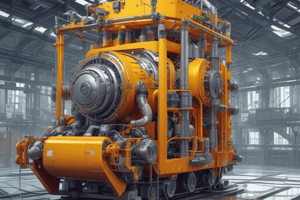Podcast
Questions and Answers
What type of polymerization involves the creation of water as a byproduct?
What type of polymerization involves the creation of water as a byproduct?
- Thermoplastic formation
- Polyadditon
- Elastomer synthesis
- Polycondensation (correct)
Which of the following statements about thermoplastics is NOT true?
Which of the following statements about thermoplastics is NOT true?
- Thermoplastics can melt.
- Thermoplastics have covalent bonds.
- Thermoplastics are exclusively rigid. (correct)
- Thermoplastics can be reshaped multiple times.
Which type of plastic is characterized by a 3D network and strong connections between chains?
Which type of plastic is characterized by a 3D network and strong connections between chains?
- Thermosets (correct)
- Elastomers
- Amorphous plastics
- Semi-crystalline plastics
Which type of plastic is known for its ability to return to its original shape after being stretched?
Which type of plastic is known for its ability to return to its original shape after being stretched?
Which of the following is an example of an amorphous plastic?
Which of the following is an example of an amorphous plastic?
What distinguishes polyaddition from polycondensation?
What distinguishes polyaddition from polycondensation?
Which type of plastic is known to be difficult to remelt and begins to decompose if attempted?
Which type of plastic is known to be difficult to remelt and begins to decompose if attempted?
Which type of plastics can vary between being disordered and having a partially ordered structure?
Which type of plastics can vary between being disordered and having a partially ordered structure?
Flashcards
Polycondensation
Polycondensation
A process where two or more molecules (monomers) join together to form a larger molecule (polymer), releasing a small molecule as a byproduct, often water.
Polyaddition
Polyaddition
A process where two or more molecules (monomers) join together to form a larger molecule (polymer), without releasing any byproducts. Often requires a catalyst and high pressure/temperature.
Thermoplastics
Thermoplastics
Plastics that can be repeatedly melted and reshaped without significant degradation.
Thermosets
Thermosets
Signup and view all the flashcards
Elastomers
Elastomers
Signup and view all the flashcards
Amorphous Thermoplastic
Amorphous Thermoplastic
Signup and view all the flashcards
Semicrystalline Thermoplastic
Semicrystalline Thermoplastic
Signup and view all the flashcards
Curing (in the context of plastics)
Curing (in the context of plastics)
Signup and view all the flashcards
Study Notes
Plastics Composition
- Plastics are composed of carbon-hydrogen bonds.
- Monomers combine to form polymers.
- Two main polymerization reactions are polycondensation and polyaddition.
Polycondensation
- Combines two or more different or identical substances.
- A water byproduct is created, which must be removed.
- Examples of plastics produced this way: polyester, polyether, polyamide.
Polyaddition
- Combines two or more identical or different substances.
- The atomic arrangement of the monomer is changed.
- Requires a catalyst and high temperature/pressure.
- No byproducts are created.
Types of Plastics
- Classified into thermoplastics, elastomers, and thermosets.
Thermoplastics
- Melt when heated.
- Covalent bonds are relatively resistant to temperature changes.
- Intermolecular bonds (like hydrogen bonds) weaken at higher temperatures. The strength depends on chemical or physical properties.
- Generally plastic, deformable, and linearly shaped.
- Can be amorphous (disordered, glassy, transparent, brittle) or semi-crystalline (partially ordered, crystalline, ductile, opaque).
- Examples: PP (polypropylene), PE-HD (high-density polyethylene), PE-LD (low-density polyethylene), PE-LLD.
Elastomers
- Soften at room temperature.
- 2D or 3D network with large meshes.
- Strong connections between chains make them elastic and spring back after being deformed.
- Examples: EPDM (ethylene propylene diene monomer).
Thermosets
- 3D network with strong connections between chains.
- Harden chemically, and cannot be melted again without decomposition happening.
- Resistant to high temperatures.
- Examples: Bakelite, Melamine formaldehyde.
- Often rigid and not easily scratched.
Studying That Suits You
Use AI to generate personalized quizzes and flashcards to suit your learning preferences.




